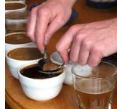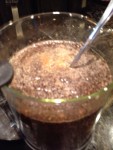Tasting Coffee
(Note: If you are looking for reviews of coffees we offer for sale, click here. On to the article…)
Ok, you aren’t a coffee geek or uber-professional barista type. Few are. You can still raise your C.E.Q. (Coffee Enjoyment Quotient) by learning about what coffee tasters look for in tasting coffee. Even novices can improve their ability to enjoy their coffee by becoming aware of the elements of coffee tasting. Here is a fun exercise to help build your CEQ:
Brew some coffee using best brewing techniques as described here. If you are tasting more than one at a time, we suggest starting with lighter roasts first. Pour a bit into a cup and let it cool to slightly above room temperature. Do not add cream, sugar or anything else just yet. Stir and slurp (loudly) about seven spoonfuls, breathing through both mouth and nose to take advantage of all your flavor receptors. Note the flavors and characteristics you sense. Here is a list of seven things you focus on while tasting:
1. Fragrance and aroma –Both wet and dry grounds smells prepare you for the tastes to come, so we note these early impressions. What kinds of flavors do you sense, and how strong are they? Sometimes a light fragrance in dry grounds blooms to much more intense aroma when hot water is added, so don’t assume an intense dry grounds fragrance will automatically translate to more intense flavor in the cup.
2. Taste –Within the overall coffee flavor, you will sense a subset of other flavors such as fruity, lively acidity, caramel, bittersweet, grapefruit, wine, figs, smoke, chocolate, leather, etc. How these tastes blend (or fight) with each other creates much of the enjoyment of a good coffee. Tasting is very subjective–No two people will sense the same exact flavors in the same proportions, but to the extent you can describe a flavor to another person, your review will be invaluable.
3. Acidity – In this context, acidity refers to the level of brightness and liveliness in the cup. It is a positive quality as long as it is kept in balance. Some coffees, especially East Africans, are known for their lively acidity that enlivens the entire flavor profile. Others, like Indonesians, are known for muted acidity that seems to emphasize the deep, dark “bass notes”.
4. Sweetness – The level of sweetness is usually distinguished from other aspects of taste, especially how mellow and smooth the coffee seems. A “sweet” coffee has no rough edges of bitterness or off-flavors. In short, all the various flavors work together harmoniously. It really has nothing to do with sugar content.
5. Complexity – Coffee is a complex beverage, more so than wine, but coffees vary in level of complexity due to several factors discussed elsewhere on our site. Here, complexity of taste refers to the number of flavors that are present and whether they complement each other. Simpler, complementary, more easily identifiable taste profiles are called “clean”. A clean profile may have fewer layers than a complex one, but both can be very good and satisfying.
6. Body and mouth feel – Is it lighter, medium, or heavy and syrupy? Different occasions call for different “weights” of coffee. For example, if your food pairing is something delicately flavored, you might want a more delicate, lightweight coffee, whereas if you are having an after-dinner coffee in lieu of dessert, you probably would want more heft to the cup.
7. Finish and aftertaste -As aroma sets you up for enjoying coffee flavor, aftertaste is a description of the sensation you experience after you swallow. Does it last a long time? Is it pleasant? Does it disappear quickly or linger on the palate?
By this point, just by paying attention to various characteristics, you have become better acquainted with this coffee. Your CEQ just rose several points. Congratulations! 🙂
As a reminder, coffee tasting (like wine tasting) is more art than science, so it could be fun to do this with someone else and compare notes, or repeat your experience with the same coffee on different days. Your mileage will vary, of course, but if you do this exercise often, it will not be long before you will have built an internal “database” of coffee flavors and profiles you especially like. That is the first step in finding coffee that fits YOU.
Read about how our featured coffees’ flavors shift with different roast levels.


